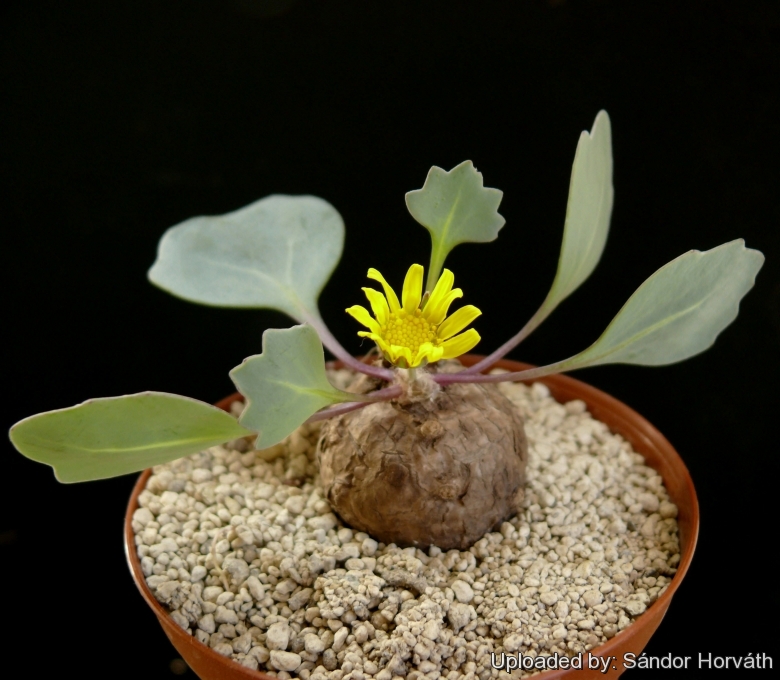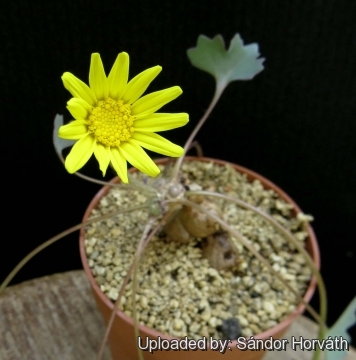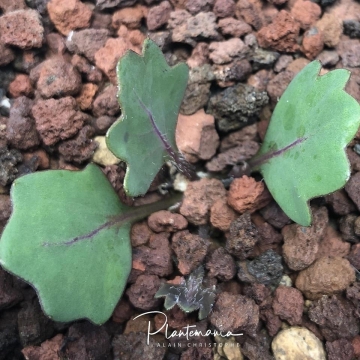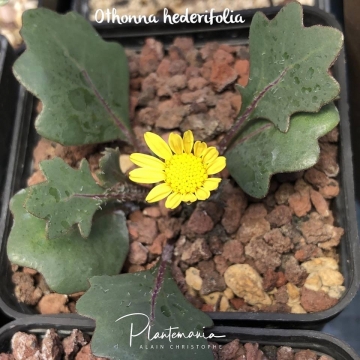
Othonna hederifolia Photo by: Sándor Horváth
Origin and Habitat: Othonna hederifoliaSN|32269]]SN|32269]] is native to the top of Van Rhyn's Pass, Vanrhynsdorp div., Northern Cape, South Africa.
Habitat and origin: This species occurs in granitic sand on flat rocks.
Synonyms:
Description: Othonna heridifolia, a nice perennial caudiciform. The caudex reaches 2.5 cm in diameter. The specific epithet hederifolia comes from Latin words meaning "ivy leaved." The leaves are 6 cm long bluish broadly cuneate with 5 rounded wavy teeth at the tip and are deciduous during the dry season. The flowers of Othonna heridifolia are bright yellow.
Rootstock: Swollen, carrot-like, cylindrical or torulose, 2-10 cm long, 1-2.5 cm on diameter.
Stem: Udeveloped.
Leaves: In a radical rosette from the woolly crown,. Petiole 2-7 cm, in habitat completely buried in sand, eaf-blades 2-2.5 cm wide, in vertical position broadly cuneate with 5 rounded wavy teeth at the tip, flat but fleshy, leathery, grey-green, glaucous, deciduous.
Inflorescence: Simple, 3-17 cm long.
Flowers (capitula): Bright-yellow 1-1.8 cm in diameter. Phyllaries c.13. Ray flower c. 13, limb 10-15 x 2.5 3 mm, yellow. Disc Flowers 50-100, yellow.
Fruits (achenes): Achenes densely villous later on in the season, pappus of marginal florets much elongated in fruit.
Chromosome number: 2n = 20.
Bibliography: Major references and further lectures
1) Goldblatt, P. and Manning, J.C. 2000. "Cape Plants: A conspectus of the Cape Flora of South Africa." Strelitzia 9. National Botanical Institute, Cape Town.
2) Raimondo, D., von Staden, L., Foden, W., Victor, J.E., Helme, N.A., Turner, R.C., Kamundi, D.A. and Manyama, P.A. 2009. "Red List of South African Plants". Strelitzia 25. South African National Biodiversity Institute, Pretoria.
3) Foden, W. & Potter, L. 2005. "Othonna hederifolia B.Nord." National Assessment: Red List of South African Plants version 2015.1. Accessed on 2016/01/09
4) Urs Eggli "Illustrated Handbook of Succulent Plants: Monocotyledons" Springer Science & Business Media, 06 December 2012
5) “Holotype of Othonna hederifolia B.Nord. [family ASTERACEAE]” <http://plants.jstor.org/stable/history/10.5555/al.ap.specimen.s-g-4416> web 07 – January 2016
 Othonna hederifolia Photo by: Sándor Horváth
Othonna hederifolia Photo by: Sándor Horváth Othonna hederifolia Photo by: © Plantemania
Othonna hederifolia Photo by: © Plantemania Othonna hederifolia Photo by: © Plantemania
Othonna hederifolia Photo by: © PlantemaniaSend a photo of this plant.The gallery now contains thousands of pictures, however it is possible to do even more. We are, of course, seeking photos of species not yet shown in the gallery but not only that, we are also looking for better pictures than those already present.
Read More... Cultivation and Propagation: ln cultivation, othonnas are dormant during summer and need water from October, when the new leaves can be seen forming on the growing tip. In April the leaves begin to go yellow and drop off, so now it rests quite dry in to summer. They must be grown very hard in the nursery as close to the natural conditions as possible. This ensures that they keep their compact habit.
Propagation: Othonna hederifolia is rare, but an easyt species to raise from seeds. Seeds should be sown in a sandy mixture and be just covered with a thin layer of silt. The seeds germinate best when sown during the cold weather and will take from several days to two weeks after sowing, but germination continues for about two months. The initial growth of othonna seedlings is very rapid. When they enter dormancy, the young plants should be kept completely dry until the following growing season.














